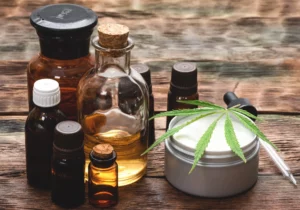For hundreds if not thousands of years, smoking was the favored way to consume cannabis in cultures around the world. Even today, inhaling the smoke produced by burning parts of the cannabis plant is still one of the most popular ways to get marijuana’s medicinal and recreational benefits.
But in recent years, vaping—inhaling vapors produced by heating the marijuana plant, extracts, oils and distillates—has changed the way people consume this ancient medicinal plant. Vaping allows consumers to avoid risks associated with smoking cannabis. But harmful additives in vaping oils, and toxins created when vaping at high temperatures, pose risks of their own.
FOLLOW US ON FACEBOOK & INSTAGRAM
Vaping Marijuana Has Advantages Over Smoking
Vaping refers to the various methods of consuming cannabis by inhaling vapors produced by heated cannabis flower, oils or other kinds of extracts from the plant. That’s a very different method than that of smoking, which involves setting cannabis buds and leaves alight and inhaling the smoke they produce as they burn.
Both smoking and vaping are highly efficient mechanisms for delivering cannabis, since they bring cannabis molecules directly to the lungs, where they enter the many small capillaries lining the lungs. From there, the cannabis molecules are transported rapidly through the bloodstream. In this way, cannabis is able to pass the blood-brain barrier relatively quickly and trigger the desired effects within minutes.
But smoking has some drawbacks. Although smoking marijuana is easier on the lungs than smoking cigarettes is, cannabis smoke is still produced by the process of combustion. And combustion creates toxins, including known carcinogens.
What’s more, it’s hard to remain discreet about smoking cannabis since the pungent smells released when cannabis is burning can clearly advertise the activity. And while smoking can provide a smoker with the full complement of compounds and terpenes in the whole plant, it’s more difficult to fine-tune that content to get very specific effects.
RELATED: THE INS & OUTS OF VAPING MARIJUANA
That’s why many marijuana consumers turn to vape pens and vaporizers. Advocates say vaping is a cleaner, more efficient and less risky way to get the many benefits of inhaling cannabis, since there’s no potentially toxic smoke involved. But the methods used to extract cannabis oils for vaping, and the way oils are heated during vaping, can also expose users to toxins and carcinogens.
Cannabis Vape Oils Can Contain Toxic Additives
Cannabis oils for vaping are created by extracting or distilling essential oils from parts of the raw cannabis plant. The various processes used to make cannabis oils both commercially and at home often rely on some highly toxic substances to complete the extraction. And residues from those toxic substances can remain in the resulting oil.
Chemicals used in extracting cannabis oils can include ethanol (alcohol), ammonia and even lighter fluid. Butane, used for creating butane hash oil, and the various solid and semi-solid versions used in dabbing, is highly flammable and toxic when inhaled or ingested. Since vaping delivers molecules from cannabis oils and other ingredients directly to the lungs and from there into the bloodstream, toxins can reach the lungs, brain and nervous system very quickly.
Cannabis concentrates used in commercially produced vape pens
can also contain other additives, such as:
- Ethanol
- Polyethylene glycol
- Propylene glycol
- Pesticides
Some of these additives are used to add flavoring and have been approved as safe for use in other ways—but not for vaping. For example, propylene glycol is considered safe to ingest, but at high temperatures, it transforms into carbonyls, a group of toxic, carcinogenic chemicals that includes formaldehyde.
Vaping Cannabis Oils at High Temperatures Creates Toxins
Vaping lets a user avoid the risks of toxins that are created during smoking by the process of combustion. But vaping cannabis oils and other kinds of extracts at very high temperatures (above 160 degrees F) creates toxins, too.
When oils are heated beyond their flash point, they begin to degrade. As they degrade, they release new chemical elements—and some of these, such as acrylamide, are highly toxic and even carcinogenic. The risk rises even more when cannabis oils are contaminated with additives or residues such as butane and ethanol. These substances add still more toxins of their own when heated to excessively high temperatures.
Controlling vaping temperatures can be difficult, and this lack of control can expose a user to toxins from multiple sources. Homemade vaporizers and dab rigs don’t have temperature controls, and neither do many commercially produced models. This allows vaping temperatures to rise quickly to unsafe levels.
As well, commercial vape pens are typically set to produce vapor at a particular temperature, without a way for users to make adjustments. The metal heating elements in some brands of vape pens and other kinds of e-cigarettes can also release toxic heavy metals such as nickel and a variety of silicates into the vapor a user inhales.
How to Stay Safe While Vaping Marijuana
So far, there are no federal safety regulations around the safety of vaping devices or concentrates. This means it’s up to you to be vigilant about the safety of your vape pens and concentrates. One key strategy is to read product labels on oils, concentrates, and vape pens and other devices. Look for chemical ingredients such as propylene glycol or other additives in cannabis concentrates. Try to buy commercially produced devices with usage guidelines and product descriptions whenever possible.
If you’re planning to use a vaporizer or a dab rig, look for ones with temperature controls. When using a device without temperature controls, such as a homemade dab rig, monitor temperatures carefully, and use ceramic nails and other heating elements whenever possible to reduce the risk of exposure to heavy metals and other industrial byproducts.
When buying a vape pen, check the manufacturer whenever possible for information about how a pen is produced and what it contains. Look for vape pens that have ceramic heating elements to avoid metals. If you’re considering a vape pen with a premade cartridge, make sure you can view a full list of ingredients. All reputable vape companies should be able to tell you exactly what’s in their vape oils.
Adjusting the way you vape can also help protect against exposure to harmful chemicals. Avoid inhaling or pressing controls on your pen too long, since this can expose your lungs to the heated concentrate itself, not just the vapor.
Cannabis vaping is growing in popularity as more users see it as a safer alternative to smoking. Vaping has its own risks, too—but careful consumers can stay safe and enjoy the health benefits of cannabis concentrates at the same time.
Photo credit: Vaping 360
If you’re new to cannabis and want to learn more, take a look at our Cannabis 101 post. HelloMD can help you get your medical marijuana recommendation; it’s easy, private and 100% online.






